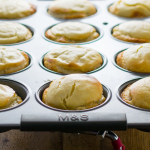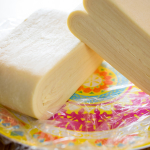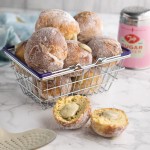Oh these are nawty little tarts. I’m sorry but there’s no getting around the fact these puff pastry and creme pat puffs – Pasteis de Nata or Portuguese Custard Tarts – are nothing but sinfully calorific but that is exactly what makes them so utterly dreamy to eat.
Speaking as someone who would have a bite of Hungry Hubby’s english custard tart but say “no thank you” to a second, I can not tell you how much I love these. They are undoubtedly best wolfed with the breath of the oven on them still but I assure you, eaten cold is hardly a crime against pastry.
[clickToTweet tweet=”How to make perfect Pasteis de Nata (Portuguese Custard Tarts) at home! ” quote=”How to make perfect Pasteis de Nata (Portuguese Custard Tarts) at home! “]It’s offensive how long it has taken me to make these. I dabbled quite a few years ago with one recipe but I didn’t fall in love until very recently. Now I know how compulsively delicious these are, I fear I will need to start a 2:5 diet – 2 days eating pasteis de nata, 5 days on bread and water. Created, it is said, by monks in the 1800s in Portugal, these pastries are hardly a new invention – more one of those classics which never grows old.
You can flavour the custard part with cinnamon, lemon, orange or vanilla and I’m sure that Portuguese families the country wide each hold what they believe to be the definitive recipe. This one relies on cinnamon in the pastry and vanilla in the custard. No reason why you can’t add a slither or two of the citrus peel to the milk as you prepare the filling but I’ll leave that up to you.
I can’t lay claim to the recipe being my own invention entirely when these are such a classic pastry but the method is all mine. In this post, I’m not going to show you how to make your own puff pastry, although it is easy and a fun thing to do yourself – that is a post in itself with lots of step by step photos and you can find it here. There is no shame in buying some ready-made as it does take a long time to prepare even though it is very simple to do.
Just buy all-butter rather than the lower fat versions which use oils that don’t taste as good and risk changing the texture of your flaky pastry. You can split the jobs up and make it easier by making the pastry and creme patisserie one day and assembling and baking the next – how fabulous would these be for an indulgent weekend breakfast?

A few final tips I think are worthy of mention:
- Keep your dough as cold as can be to make handling easier, don’t be afraid of returning to the fridge to firm up if needed.
- When making the creme pat, it is worth using a timer for the minute of high heat whisking to ensure you don’t over estimate it and risk scrambling the eggs – don’t be scared, it’s easier than it sounds!
- Definitely preheat your oven for this one (using an oven thermometer) – if the temp isn’t high enough, you won’t get the characteristic brown blisters on top. If you have a fan oven, this is the time to use it as it will give you that characteristic burnished top to the custard and pastry.
- Use a [easyazon_link identifier=”B0001IWYFA” locale=”UK” tag=”evnocr-21″]welsh bakestone[/easyazon_link] on the shelf you bake the pasteis on to get the bottoms good and crisp.
- Mince pie (or jam tart) tins are great to use as they are round bottomed and therefore make it super easy to get the tarts out when they are cooked – I love [easyazon_link identifier=”B000FLT7LM” locale=”UK” tag=”evnocr-21″]these ones[/easyazon_link] but you will need two as they are much smaller than muffin tins (what a shame – extra tarts! 😉 ).

The national sweet treat of Portugal, Pasteis de Nata are commonly flavoured with vanilla and cinnamon but you could use lemon instead of or as well if you prefer. Custard tarts like you have never had before!
- 500 g puff pastry
- 2 tsp ground cinnamon
- 4 tbsp icing sugar
- 6 egg yolks
- 450 ml semi-skimmed milk
- 50 ml double cream
- 1 vanilla bean
- 120 g caster sugar
- 100 g plain flour
-
Roll the pastry out into a large rectangle (the exact measurements are not important) about 5mm thick, sprinkling the work surface and dough liberally with the icing sugar.
-
Sprinkle with the cinnamon and a little more icing sugar then roll up like a swiss roll and cut into 12 equally sized pieces. If you are using mince pie/jam tart tins, you will get almost double the amount. If you only have one tin, keep half the pastry in the fridge until the first batch is baked.
-
Take each “roll” of pastry and turn it cut side up. Flatten and roll out a few millimetres (quarter inch) thick, big enough to line a muffin cup with a tiny amount of pastry above the rim (allows for shrinkage). Chill until needed.
-
Make the creme patisserie – whisk the egg yolks and sugar together in a medium sized bowl bowl or large jug and then sift over and whisk in the flour. This minimises lumpiness.
-
Place the milk and cream in a sauce pan and scrape in the seeds of the vanilla bean. Pop in the bean for good measure and bring to the boil over high heat.
-
Remove the vanilla pod then in a very slow, thin stream, pour the cream over the egg yolk mixture, whisking rapidly - it will start to thicken immediately if you have got your cream hot enough. If there is any burnt milk in the saucepan, wash and dry it before scraping the custard back into it. Bring to the boil one final time, whisking constantly until very thick and heavy on the whisk - it should take less than a minute.
-
Pass the custard through a fine meshed sieve to remove any lumps into a clean jug or bowl then cover the surface with clingfilm and leave to cool to room temperature. Store in the fridge overnight if not using immediately.
-
Remove pastry from the fridge and dollop in the creme pat until it comes 1-2mm below the pastry case rims. It will puff dramatically in the oven but is thick enough not to spill out. I use a large piping bag actually which is much faster.
-
If you have a Welsh bakestone, place it in the oven as it preheats to 220°C WITH THE FAN ON* for 10-12 minutes until the pastry is cooked through and deep golden brown and the custard is browned on top and will have puffed up to almost double it’s height – it falls on cooling and leaves a dimpled surface.
-
Leave to cool for 5 minutes only then carefully remove from the tin with a plastic knife if they have caught anywhere. Transfer to a rack for 10-15 minutes to cool as the sugar in the pastry will make these hot, hot, hot! Dive in and indulge as soon as they are room temperature.
Note these little tarts puff up like crazy on baking - don't be scared, this is normal! They start to sink after you take them out the oven and they will sag and crinkle a little. Again - this is normal!
*= If you don't have a fan oven, increase the temperature to 240˚C to ensure you get a good crisp finish with burnished tops.
This post contains affiliate links, meaning I will earn a little commission if you chose to buy items I’ve advertised, helping me to bring you all these recipes for free!
Like this post? Then why not try these related recipes:
- Homemade Puff Pastry
- Ooey Gooey Cheese Pies
- Banana & Custard Donuts









Beautifully bake, Jo – they look fantastic. It would be nutmeg for me I fear, but either way I’d devour the lot…
Oh now, I did consider putting that on top – hubby would love it but I forgot if the truth be told!
Well, these can’t be all that bad as you make them out to be. The way I look at it, eggs are a protein and you do use semi-skimmed milk!
They look lovely and oh so delicious!
Ha! I love your rationale there Alyssa – these tarts are practically health food by those standards hehe 😉
I have wanted to make these for so long – thanks for sharing the recipe it looks so delicious.
You’re welcome Angela – they are really quick and easy to make, I hope you give them a try!
Oh wow! These have been on my list for quite a while but I still haven’t tried them. Yours look incredible and I love the tips you included.
Aw thank you Tara – am glad they were helpful 😀
I used to live in a city that offered pasteis at the cash register. Always loved them & thanks for the Rx!
Oh wow – how lucky were you! But they are quick to make so I can’t get too jealous 😉
Oooh I love creme pat cakes/tarts, these definitely look like they’d be hard to stop after one!
They so are Emily – they suck you in and force you to eat another 😉